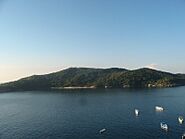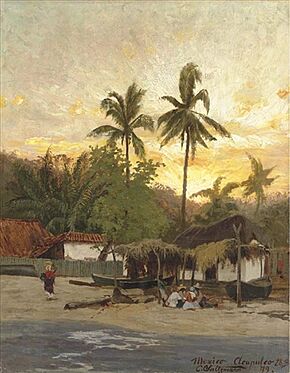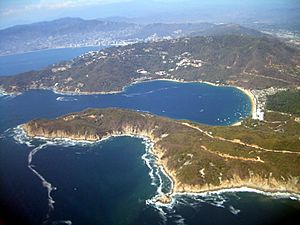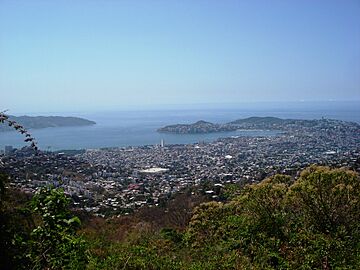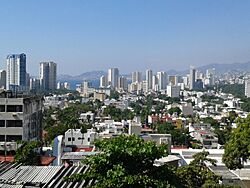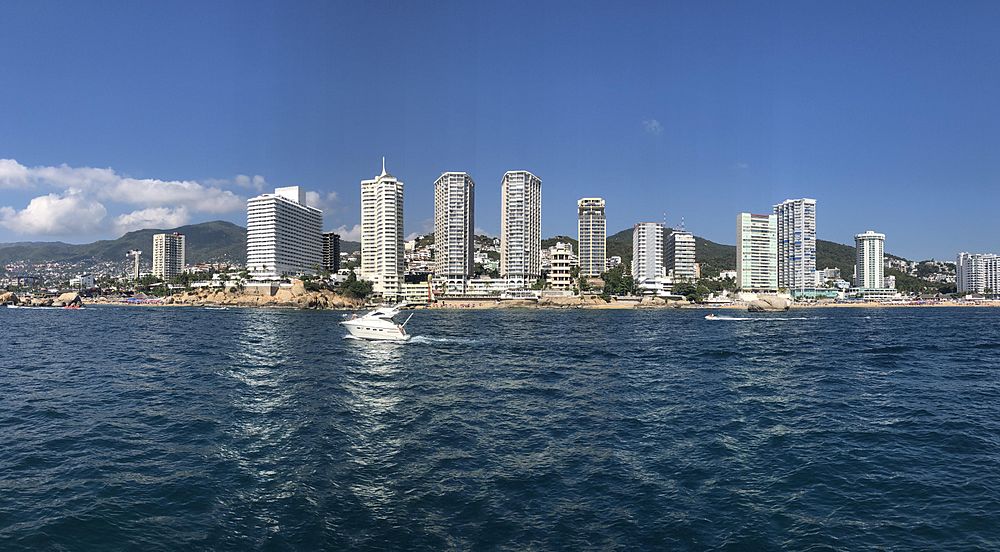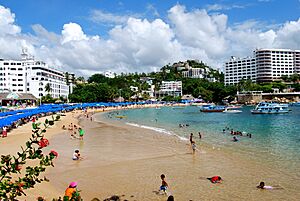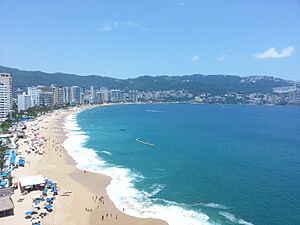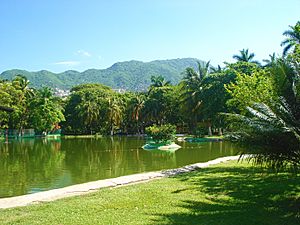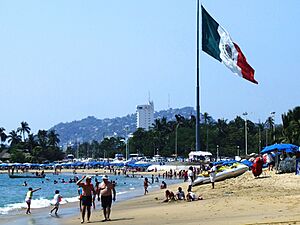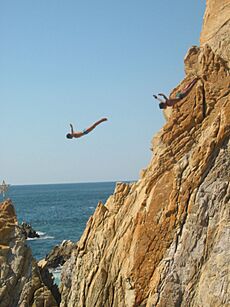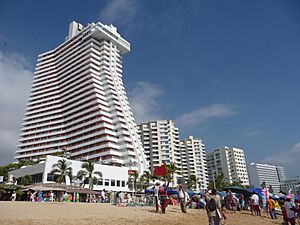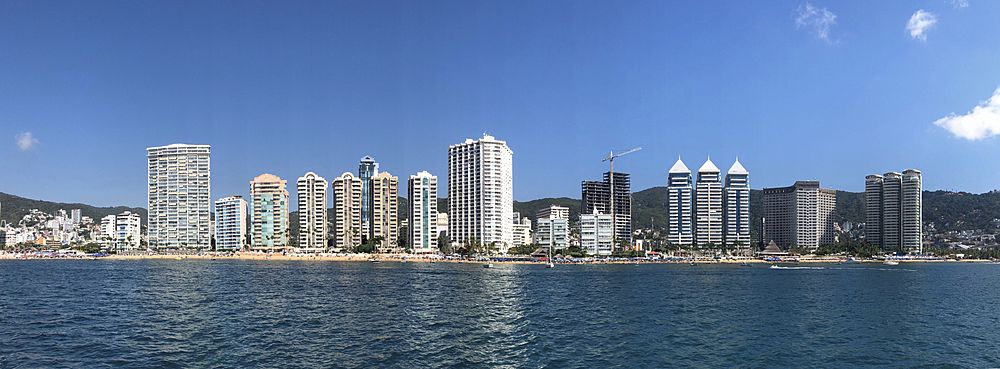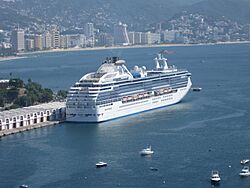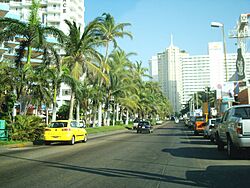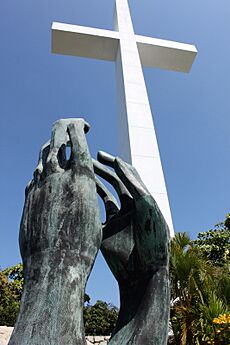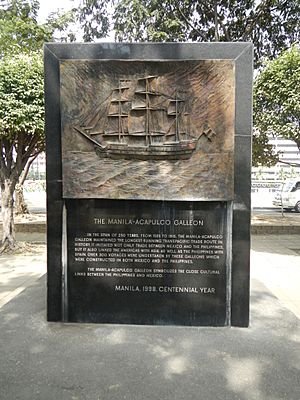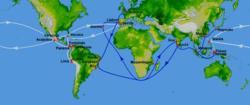Acapulco facts for kids
Quick facts for kids
Acapulco
|
||
|---|---|---|
| Acapulco de Juárez | ||
|
Acapulco skyline
Skyscrapers in Diamante
Acapulco Cathedral
La Roqueta Island
|
||
|
||
| Country | Mexico | |
| State | Guerrero | |
| Municipality | Acapulco, Guerrero | |
| Founded | March 12, 1550 | |
| Area | ||
| • City | 1,880.60 km2 (726.10 sq mi) | |
| • Urban | 85 km2 (33 sq mi) | |
| • Metro | 3,538.5 km2 (1,366.2 sq mi) | |
| Elevation
(of seat)
|
30 m (100 ft) | |
| Population
(2020 census)
|
||
| • City | 658,609 | |
| • Density | 350.2122/km2 (907.0453/sq mi) | |
| • Metro | 852,622 | |
| Demonyms | Acapulqueño (a) Porteño (a) |
|
| GDP (PPP, constant 2015 values) | ||
| • Year | 2023 | |
| • Total | $10.3 billion | |
| • Per capita | $10,100 | |
| Time zone | UTC−6 (CST) | |
| • Summer (DST) | UTC−5 (CDT) | |
| Postal codes |
39300–39937
|
|
| Area code(s) | 744 | |
Acapulco de Juárez, often called Acapulco, is a city and a big seaport in the state of Guerrero, Mexico. It's located on the Pacific Coast of Mexico, about 380 kilometers (236 miles) south of Mexico City. Acapulco sits on a deep, curved bay and has been an important port since Mexico's early colonial days. It's a stop for ships and cruise lines traveling between Panama and San Francisco, California, United States. Acapulco is the largest city in Guerrero, much bigger than the state capital, Chilpancingo. It's also Mexico's biggest beach and resort city.
Acapulco is one of Mexico's oldest beach resorts. It became very famous in the 1940s to 1960s as a favorite getaway for Hollywood stars and wealthy people. While it was once a very popular place for tourists from all over the world, Acapulco has faced some challenges recently, which means fewer international tourists visit. Most visitors now come from Mexico itself.
The resort area is split into three main parts. The north end of the bay is the "traditional" area, with places like Parque Papagayo and the Zócalo (main square). The middle part of the bay is called the "Zona Dorada" (Golden Zone), where many famous people used to vacation. The south end, called "Diamante" (Diamond), has newer, fancy hotels and apartments.
The name "Acapulco" comes from the Nahuatl language, Aca-pōl-co. It means "where the reeds were destroyed or washed away" or "at the big reeds." This meaning inspired the city's official seal, which shows two hands breaking reeds. The "de Juárez" part was added in 1885 to honor Benito Juárez, a former president of Mexico.
Contents
History
Early Times
Around the 8th century, a small culture lived near Acapulco Bay. This area was later influenced by the Olmecs and other groups before the Spanish arrived in the 1520s. The Olmecs helped small villages grow into bigger communities and build special ceremonial places.
Later, influences from Teotihuacan and the Mayans reached the area. We know this from old items found at places like Playa Hornos and Pie de la Cuesta. In the 11th century, new groups of Nahuas, who were related to the Aztecs, moved into the area. In the late 15th century, Acapulco became part of the Aztec Empire. However, the local Yopis continued to live there and defend their land until the Spanish arrived.
16th Century
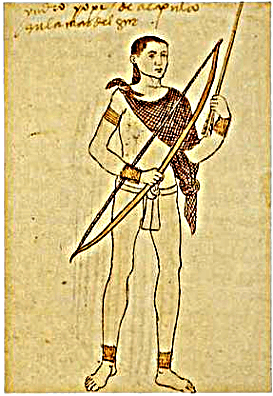
Europeans discovered Acapulco Bay in the early 1520s. One story says Hernán Cortés sent explorers to find gold. Another says a ship captained by Santiago Guevara found the bay in 1526.
In 1531, some Spaniards founded the village of Villafuerte where Acapulco is today. Cortés soon made Acapulco an important port. The first main road between Mexico City and Acapulco was built by 1531.
Spanish trade with the Far East made Acapulco very important. In 1550, thirty Spanish families moved here to create a permanent European settlement. By 1565, large Spanish ships called Galleons began arriving from Asia. Acapulco became the second most important port in New Spain (Mexico) because of its direct trade with the Philippines. This trade was mainly through the yearly Manila-Acapulco Galleon route, which connected New Spain, Europe, and Asia. In 1573, Acapulco was given the sole right to handle this trade.
17th to 19th Centuries
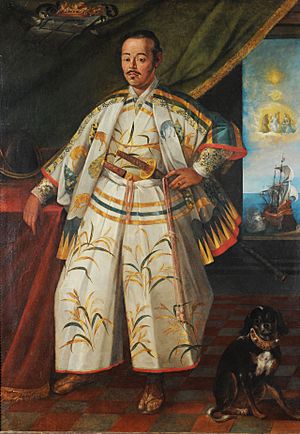
On January 25, 1614, a group led by samurai Hasekura Tsunenaga arrived in Acapulco from Japan. This group included over a hundred Japanese Christians and twenty-two samurai. They came to build stronger ties with Catholic Europe. Some of Tsunenaga's group even stayed and married local people.
The yearly galleon trade continued from the mid-16th century until the early 19th century. The valuable goods brought to New Spain attracted English and Dutch pirates like Francis Drake and Henry Morgan. A Dutch fleet attacked Acapulco in 1615, destroying much of the town before being driven away. The Fort of San Diego was built the next year to protect the port and its cargo. An earthquake destroyed the fort in 1776, but it was rebuilt between 1778 and 1783.
In the early 1800s, King Charles IV declared Acapulco an official city. However, the Mexican War of Independence soon began. In 1810, José María Morelos y Pavón attacked and burned the city. When Mexico gained independence in 1821, the Manila Galleon trade ended. Acapulco's importance as a port grew again during the California Gold Rush in the mid-19th century, as ships traveling to and from Panama stopped here.
20th Century
In 1911, revolutionary forces took over Acapulco's main square. In 1920, the Prince of Wales (who later became King Edward VIII) visited the area. He was very impressed and told his friends in Europe about it, making Acapulco popular with wealthy people. Much of the first hotels and businesses were built by Albert B. Pullen from Texas. In the late 1930s, a company called “La Fraccionadora de Acapulco, S.A.” (FASA) really started to develop tourism.
In the mid-1940s, the first commercial dock and warehouses were built. In the early 1950s, President Miguel Alemán Valdés improved the port's facilities, adding electricity, drainage, roads, and the first highway to connect Acapulco with Mexico City.
The economy grew, and more foreign money came in. During the 1950s, Acapulco became the trendy spot for Hollywood stars like Elizabeth Taylor, Frank Sinatra, and Brigitte Bardot. The 1963 movie Fun in Acapulco, starring Elvis Presley, helped make the city even more famous.
Acapulco's population grew from about 4,000 in the 1940s to around 50,000 by the early 1960s. For the 1968 Summer Olympics in nearby Mexico City, Acapulco hosted the sailing events.
During the 1960s and 1970s, more hotels were built, and travel became cheaper. It was no longer just for millionaires; middle-class people from Mexico and other countries could now afford to visit. In the 1970s, the port expanded significantly.
The Miss Universe 1978 pageant was held in Acapulco. In 1983, the singer-songwriter Juan Gabriel wrote the song "Amor eterno," which celebrates Acapulco.
The toll road called Ruta del Sol was built in the 1990s, connecting Mexico City and Acapulco. The trip now takes only about three and a half hours, making Acapulco a popular weekend spot for people from Mexico City. This helped the city's economy, and new services appeared, like the Colegio Nautilus, a school for children of local and foreign investors needing a bilingual education.
The port continued to grow. In 1996, a new private company, API Acapulco, was created to manage port operations. Acapulco is now a major port for exporting cars to the Pacific.
In 1997, Hurricane Pauline hit the city hard. It left many tourists stranded and caused over 100 deaths. Most victims were from poor areas built on steep hillsides. The main road, Avenida Costera, became a fast-moving river of mud.
21st Century
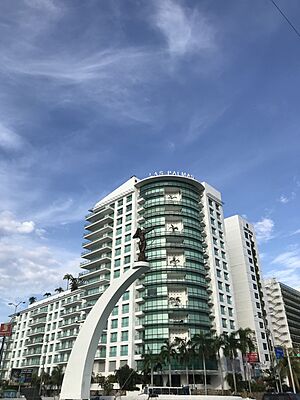
In the 21st century, Acapulco has faced challenges that have affected tourism.
Hurricane Otis
On October 25, 2023, Hurricane Otis, a very strong Category 5 hurricane, caused widespread damage across the city when it hit the coast nearby.
Geography
Acapulco is located on Mexico's Pacific coast in the state of Guerrero. The city is one of the state's seven regions. About 40% of the area is mountains, another 40% is gently sloped, and 20% is flat. The elevation ranges from sea level up to 1,699 meters (5,574 feet). The highest mountains are Potrero, San Nicolas, and Alto Camarón.
The main river in the area is the Papagayo. There are also two small lagoons, Tres Palos and Coyuca, and some hot springs.
Climate
Acapulco has a tropical wet and dry climate. This means it's hot with clear wet and dry seasons. Temperatures are more even throughout the year compared to resorts further north in Mexico. The warmest areas are by the sea, where the city is. Pacific hurricanes and tropical storms can happen from May to November. For example, Hurricane Otis hit the city directly in October 2023, causing a lot of damage. The forests tend to lose their leaves during the dry winter, but evergreen pine trees grow in the highest areas. You can find deer, small mammals, many kinds of birds, and sea animals like turtles here.
| Climate data for Acapulco (1951–2010) | |||||||||||||
|---|---|---|---|---|---|---|---|---|---|---|---|---|---|
| Month | Jan | Feb | Mar | Apr | May | Jun | Jul | Aug | Sep | Oct | Nov | Dec | Year |
| Record high °C (°F) | 39.5 (103.1) |
35.5 (95.9) |
35.5 (95.9) |
37.0 (98.6) |
38.0 (100.4) |
36.0 (96.8) |
37.5 (99.5) |
37.5 (99.5) |
36.0 (96.8) |
36.0 (96.8) |
35.5 (95.9) |
36.5 (97.7) |
39.5 (103.1) |
| Mean daily maximum °C (°F) | 30.4 (86.7) |
30.4 (86.7) |
30.4 (86.7) |
30.8 (87.4) |
31.6 (88.9) |
31.9 (89.4) |
32.3 (90.1) |
32.2 (90.0) |
31.6 (88.9) |
31.7 (89.1) |
31.4 (88.5) |
30.9 (87.6) |
31.3 (88.3) |
| Daily mean °C (°F) | 26.8 (80.2) |
27.0 (80.6) |
26.9 (80.4) |
27.4 (81.3) |
28.3 (82.9) |
28.5 (83.3) |
28.7 (83.7) |
28.6 (83.5) |
28.2 (82.8) |
28.4 (83.1) |
28.1 (82.6) |
27.5 (81.5) |
27.9 (82.2) |
| Mean daily minimum °C (°F) | 23.3 (73.9) |
23.5 (74.3) |
23.5 (74.3) |
24.0 (75.2) |
25.1 (77.2) |
25.2 (77.4) |
25.1 (77.2) |
25.1 (77.2) |
24.7 (76.5) |
25.1 (77.2) |
24.8 (76.6) |
24.1 (75.4) |
24.5 (76.1) |
| Record low °C (°F) | 18.5 (65.3) |
19.5 (67.1) |
17.0 (62.6) |
16.0 (60.8) |
19.0 (66.2) |
18.0 (64.4) |
19.0 (66.2) |
19.0 (66.2) |
20.5 (68.9) |
16.0 (60.8) |
20.0 (68.0) |
20.0 (68.0) |
16.0 (60.8) |
| Average precipitation mm (inches) | 14.8 (0.58) |
5.8 (0.23) |
2.2 (0.09) |
3.2 (0.13) |
26.1 (1.03) |
263.3 (10.37) |
246.9 (9.72) |
295.2 (11.62) |
309.6 (12.19) |
138.8 (5.46) |
20.1 (0.79) |
10.8 (0.43) |
1,336.8 (52.63) |
| Average precipitation days (≥ 0.1 mm) | 1.0 | 0.4 | 0.3 | 0.2 | 2.6 | 12.4 | 12.4 | 13.6 | 14.3 | 7.9 | 1.7 | 0.8 | 67.6 |
| Average relative humidity (%) | 74 | 73 | 72 | 74 | 74 | 75 | 76 | 76 | 78 | 77 | 75 | 75 | 75 |
| Mean monthly sunshine hours | 272.2 | 249.4 | 287.0 | 273.5 | 252.2 | 205.9 | 223.5 | 230.5 | 194.0 | 244.8 | 256.8 | 255.3 | 2,945.1 |
| Source 1: Servicio Meteorologico Nacional (Mexico) (humidity 1981–2000) | |||||||||||||
| Source 2: NOAA (sun 1961–1990) | |||||||||||||
| Jan | Feb | Mar | Apr | May | Jun | Jul | Aug | Sep | Oct | Nov | Dec |
|---|---|---|---|---|---|---|---|---|---|---|---|
| 28.1 °C (82.6 °F) | 28.2 °C (82.8 °F) | 27.6 °C (81.7 °F) | 28.6 °C (83.5 °F) | 29.4 °C (84.9 °F) | 29.7 °C (85.5 °F) | 29.9 °C (85.8 °F) | 30.0 °C (86.0 °F) | 29.9 °C (85.8 °F) | 29.5 °C (85.1 °F) | 29.1 °C (84.4 °F) | 28.7 °C (83.7 °F) |
The sea temperature is quite steady, usually between 28°C (82°F) and 30°C (86°F).
Population
Acapulco is the most populated city in the state of Guerrero. In 2020, the city had 658,609 people. Of these, 324,746 were men and 348,733 were women. It is the twenty-second most populated city in Mexico. The city holds about 85% of the total population of the Acapulco municipality.
The larger Acapulco metropolitan area includes towns from two different municipalities. In 2010, this area had 863,431 people living in it.
| Historical population | ||
|---|---|---|
| Year | Pop. | ±% |
| 1900 | 4,932 | — |
| 1910 | 5,900 | +19.6% |
| 1921 | 5,768 | −2.2% |
| 1930 | 6,529 | +13.2% |
| 1940 | 9,993 | +53.1% |
| 1950 | 28,512 | +185.3% |
| 1960 | 49,149 | +72.4% |
| 1970 | 174,378 | +254.8% |
| 1980 | 301,902 | +73.1% |
| 1990 | 515,374 | +70.7% |
| 2000 | 620,656 | +20.4% |
| 2010 | 673,479 | +8.5% |
| 2020 | 658,609 | −2.2% |

- Notes
-
- Population census (1895 – 1990, 2000 and 2010)
- Population Counts (1995 and 2005)
Economy and Tourism
Tourism is the main way people make money in Acapulco. Most of this activity happens around Acapulco Bay. About 73% of the people in the area work in businesses, mostly related to tourism and the port. Mining and manufacturing employ less than 20%, and only about 5% work in farming.
Acapulco is one of Mexico's oldest beach destinations. It became famous in the 1950s as a vacation spot for Hollywood stars and wealthy people.
The city has three main tourist areas:
- Traditional Acapulco is the older part of the port. It includes hotels like Hotel Los Flamingos, once owned by famous people like Johnny Weissmuller and John Wayne. You can find attractions like Caleta and Caletilla beaches, the La Quebrada Cliff Divers, and the main city square, El Zocalo. This area was most popular from the late 1930s to the 1960s. Today, it mostly serves Mexican visitors.
- Acapulco Dorado (Golden Acapulco) grew between the 1950s and 1970s. It's about 25 minutes from the airport and has the most tourists. It runs along much of Acapulco Bay, from Icacos to Papagayo Park, along the main road, Costera Miguel Aleman Avenue. It has many hotels.
- Acapulco Diamante (Diamond Acapulco) is the newest and most developed part of the port. It has many luxury hotels, resorts, fancy apartments, spas, restaurants, shopping areas, and a golf course. It starts at the Scenic Highway and goes to Barra Vieja Beach, just 10 minutes from the airport.
Acapulco is known for its lively nightlife and party atmosphere. From November to April, many luxury cruise ships stop here. Even though Acapulco is famous worldwide, most of its visitors come from central Mexico, especially from Mexico City. Acapulco is also a starting point for the Mexican cruise line Ocean Star Cruises.
For the 2009 Christmas season, Acapulco welcomed 470,000 visitors, mostly Mexicans. This brought in 785 million pesos for the economy. About 80% of visitors arrive by land, and 18% by air. The area has over 25,000 apartments, many of which are second homes for their Mexican owners. Acapulco is still popular with Mexican celebrities and wealthy people, like Luis Miguel and Plácido Domingo, who have homes there.
Challenges
Over the years, Acapulco has faced some issues. For example, there are many people selling things on the beaches. While this can bother tourists who want to relax, the government says it's hard to stop because many people in the city need work and face poverty. Also, there are many small, informal settlements on the hillsides around the city, where people who came looking for jobs live.
Another issue has been garbage in the bay. Even though a lot of trash has been removed, more needs to be done. Trash often ends up in the bay because it's sometimes thrown into streets, rivers, and the bay itself. The most common items found are beer bottles and car tires. However, Acapulco has made progress, with some beaches earning "blue flag" certifications for being clean and having good water quality.
Local Food
Acapulco's food is very tasty! Here are some typical dishes:
- Relleno is baked pork cooked with vegetables and fruits like potatoes, raisins, carrots, and chili peppers. It's often eaten with a type of bread called bolillo.
- Pozole is a soup with a salsa base (it can be white, red, or green), hominy (corn kernels), and meat (pork or chicken). It's served with snacks like tostadas, tacos, and tamales. This dish is a weekly tradition in the city and state, with many restaurants offering it along with special entertainment like bands or dancers.
Fun Things to Do
Acapulco's main draw is its nightlife, which has been famous for decades. Nightclubs often change names and owners. For example, Baby 'O has been open since 1976 and has hosted celebrities like Mexican singer Luis Miguel and Bono from U2. Another club, Palladium, offers amazing views of Santa Lucia Bay at night.
Many hotel bars offer free live entertainment. There are also beach bars, popular with younger crowds, that play techno or alternative rock music. These are mostly found along the Costera road. You can also find a bungee jump in this area.
Another famous attraction in Acapulco is the La Quebrada Cliff Divers. This tradition started in the 1930s when young men would compete to see who could dive from the highest point into the sea. Today, the divers are professionals. They jump from heights of 40 meters (130 feet) into a narrow inlet that is only 7 meters (23 feet) wide and 4 meters (13 feet) deep. Before diving, they pray at a shrine to the Virgin of Guadalupe. On the night before December 12, the Virgin's feast day, divers jump into the sea to honor her. The dives can be simple or very complex, ending with the "Ocean of Fire," where the sea is lit with gasoline, creating a circle of flames for the diver to aim for. You can watch this show from a public viewing area (for a small fee) or from the Hotel Plaza Las Glorias/El Mirador's bar or restaurant terrace.
Acapulco Bay and the nearby coast have many beaches. Inside the bay, you'll find La Angosta, Caleta, Caletilla, Hornos, Condesa, and Icacos, among others. In the smaller Puerto Marqués Bay, there's Pichilingue and Las Brisas. Just outside the bays are Pie de la Cuesta and Playa Revolcadero. There are also two lagoons, Coyuca and Tres Palos, both with mangroves and offering boat tours. Tres Palos also has protected areas where sea turtles lay their eggs.
Besides sunbathing, the beaches offer activities like boat rentals, boat tours, horseback riding, and scuba diving. A popular boat trip goes from Caletilla Beach to Roqueta Island, where you can snorkel, have lunch, and see a lighthouse. There's also an underwater statue of the Virgin of Guadalupe, placed there in 1958 to remember divers who died. Many scuba diving tours visit this area, which has sunken ships and underwater rock formations. Deep-sea fishing is also popular, especially for sailfish, which can weigh between 89 and 200 pounds.
In the old part of the city, you'll find the Zócalo, a traditional main square with shady trees, cafés, and shops. At the north end of the square is the Nuestra Señora de la Soledad cathedral, known for its blue, onion-shaped domes. This building was first built as a movie set before becoming a church. Acapulco's most historic building is the Fort of San Diego, built in 1616 to protect the city from pirates. The fort was rebuilt after an earthquake in 1776 and now serves as the Museo Histórico de Acapulco (Acapulco Historical Museum). It shows the port's history from ancient times until Mexico's independence.
The El Rollo Acapulco is a water park with wave pools, water slides, and dolphin shows. You can even swim with dolphins! This park is great for kids. Another fun place for children is Parque Papagayo, a large family park with a replica of a Spanish galleon, artificial lakes, an aviary (bird house), a skating rink, and rides.
The Dolores Olmedo House in downtown Acapulco is famous for the murals by Diego Rivera that decorate it. Rivera spent his last two years here, painting and creating tile mosaics on the outside walls that show Aztec gods. The inside of the home is also covered in murals. Since it's not a museum, only the outside murals can be seen by the public.
There's a small museum called Casa de la Máscara (House of Masks) dedicated to masks from Mexico and around the world. It has about a thousand masks, divided into different rooms showing their history and meaning.
The Botanical Garden of Acapulco is a tropical garden on land owned by the Universidad Loyola del Pacífico. Most of the plants here are native to the region, and many, like the purple stick tree, are in danger of disappearing.
A cultural event held yearly in Acapulco is the Festival Internacional de la Nao. It takes place at the Fort of San Diego and celebrates the city's history of trade and connections with Asian countries since the 16th century. The festival includes cultural activities with support from countries like India, China, Japan, and the Philippines. There are film screenings, music, theater, and cooking classes, with some events just for kids.
The annual French Festival happens throughout Acapulco and helps connect Mexican and French cultures. It features fashion shows and a gourmet food fair. French writers and speakers give talks, and some local nightclubs even have French DJs. Other festivals include Carnival and a crafts and livestock fair in November called the Nao de China.
Acapulco has several golf courses, including the Acapulco Princess and the Pierre Marqués course. The most exclusive is the Tres Vidas Golf Club, located by the ocean.
Another famous sports event is the Mexican Open tennis tournament, which has been held in Acapulco since 1993. It's a big event that attracts top tennis players from around the world, like Novak Djokovic and Rafael Nadal.
Acapulco also has a bullring called the Plaza de Toros, near Caletilla Beach. Bullfighting events happen during the winter season.
Spring Break
Before 2010, over 100,000 American teenagers and young adults traveled to Mexico for spring break each year. Acapulco became a popular choice, especially for its fancy hotels and famous nightlife. However, in February 2009, the US State Department issued a travel alert for college students planning trips to Acapulco. This led many schools to warn their students about traveling to Mexico during spring break.
Transportation
Nine passenger airlines, including four international ones, fly to Acapulco International Airport. In the city, you can find many buses and taxi services. Most locals prefer to walk. However, a common way to get around is using the government-supported 'Colectivo' cab system. These cabs cost 13 pesos per person, but they are not private. The driver will pick up more passengers if there are empty seats, and they drop people off based on who got in first. Each colectivo cab travels in a specific part of the city.
The bus system can be a bit confusing. The more expensive buses have air conditioning, while cheaper ones do not. For tourists, the city has yellow buses with "Acapulco" painted on the side. These are the nicest buses and travel along the tourist section of Acapulco. Many privately operated buses are uniquely decorated with decals and custom designs, from comic book scenes to "Hello Kitty" themes.
The bus network was made simpler on June 25, 2016, with the start of the Acabús. This bus rapid transit system covers 36.2 kilometers (22.5 miles) and has 16 stations along five routes. You pay for your ride at the stations before getting on, which makes boarding faster.
International Relations
Consulates
| Country | Type | Ref. |
|---|---|---|
| Canada | Consular agency | |
| United States | Consular agency | |
| The Russian Federation | Honorary consul | |
| Finland | Honorary consul | |
| France | Honorary consul | |
| Philippines | Honorary consul | |
| Poland | Honorary consul | |
| Spain | Honorary consul | |
| United Kingdom | Honorary consul |
Sister Cities
International
Mexican Cities
 Teocaltiche, 2005
Teocaltiche, 2005 Dolores Hidalgo, 2009
Dolores Hidalgo, 2009 Guanajuato City, 2010
Guanajuato City, 2010 Boca del Río, 2012
Boca del Río, 2012 Morelia, 2013
Morelia, 2013
UNESCO World Heritage Site Nominations
In 2014, Mexico and the Philippines started the idea to nominate the Manila-Acapulco Galleon Trade Route as a UNESCO World Heritage Site. This means it would be recognized as a very important place for everyone in the world.
Experts met in 2015 to prepare the nomination. They discussed different parts of the route's history, like how ships traveled, shipyards, maps, forts, food, and textiles. The goal is to show how special and important this trade route was.
Spain has also supported the nomination of the Manila-Acapulco Trade Route. They also suggested that the old records and documents from the Manila-Acapulco Galleons should be added to a separate UNESCO list called the Memory of the World Register.
| Type (criteria) | Site | Location | Description | Image | Ref |
|---|---|---|---|---|---|
| Mixed | The Historic Manila‑Acapulco Galleon Trade Route | Philippines and Mexico |
See Also
 In Spanish: Acapulco de Juárez para niños
In Spanish: Acapulco de Juárez para niños







